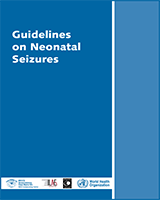| 1. | Clinically apparent seizures in the neonate should be treated if they last more than 3 minutes or are brief serial seizures. | Strong | Not graded |
| In specialized care facilities where electroencephalography is available, all electrical seizures, even in the absence of clinically apparent seizures, should also be treated. | Strong, context-specific | Not graded |
|
|
| 2. | In all neonates with seizures, hypoglycaemia should be ruled out and treated if present before antiepileptic drug treatment is considered. | Strong | Not graded |
| If facilities for measuring glucose are not available, consider empirical treatment with glucose. | Weak, context-specific |
| If there are clinical signs suggestive of associated sepsis or meningitis, central nervous system infection should be rule out by doing a lumbar puncture, and treated if present with appropriate antibiotics. | Strong |
| If facilities for lumbar puncture are not available, consider empirical treatment with antibiotics for neonates with clinical signs of sepsis or meningitis. | Weak, context-specific |
| In all neonates with seizures, serum calcium should be measured (if facilities are available) and treated if hypocalcaemia is present. | Strong, context-specific |
| In the absence of hypoglycaemia, meningitis, hypocalcaemia or another obvious underlying etiology such as hypoxic-ischaemic encephalopathy, intracranial haemorrhage or infarction, pyridoxine treatment may be considered before antiepileptic drug treatment in a specialized centre where this treatment is available. | Weak, context-specific |
|
|
| 3. | Phenobarbital should be used as the first-line agent for treatment of neonatal seizures; phenobarbital should be made readily available in all settings. | Strong | Very low |
|
|
| 4. | In neonates who continue to have seizures despite administering the maximal tolerated dose of phenobarbital, either a benzodiazepine, phenytoin or lidocaine may be used as the second-line agent for control of seizures (use of phenytoin or lidocaine requires cardiac monitoring facilities). | Weak | Very low |
|
|
| 5. | In neonates with normal neurological examination and/or normal electroencephalography, consider stopping antiepileptic drugs if neonate has been seizure-free for >72 hours; the drug(s) should be reinstituted in case of recurrence of seizures. | Weak | Very low |
|
|
| 6. | In neonates in whom seizure control is achieved with a single antiepileptic drug, the drug can be discontinued abruptly without any tapering of the doses. | Weak | Not graded |
| In neonates requiring more than one antiepileptic drug for seizure control, the drugs may be stopped one by one, with phenobarbital being the last drug to be withdrawn. | Weak |
|
|
| 7. | In the absence of clinical seizures, neonates with hypoxic-ischaemic encephalopathy need not to be given prophylactic treatment with phenobarbital. | Strong | Moderate |
|
|
| 8. | Where available, all clinical seizures in the neonatal period should be confirmed by electroencephalography. | Strong, context-specific | Not graded |
| Electroencephalography should not be performed for the sole purpose of determining the etiology in neonates with clinical seizures. | Strong |
|
|
| 9. | Radiological investigations (ultrasound, computed tomography and magnetic resonance imaging) of the cranium/head should not be performed to determine the presence or absence of clinical seizures or to evaluate the efficacy of treatment with antiepileptic drugs in neonates. | Strong | Not graded |
| Radiological investigations may be done as a part of the comprehensive evaluation of the etiology of neonatal seizures or to determine prognosis in neonates with seizures. | Weak, context-specific |
